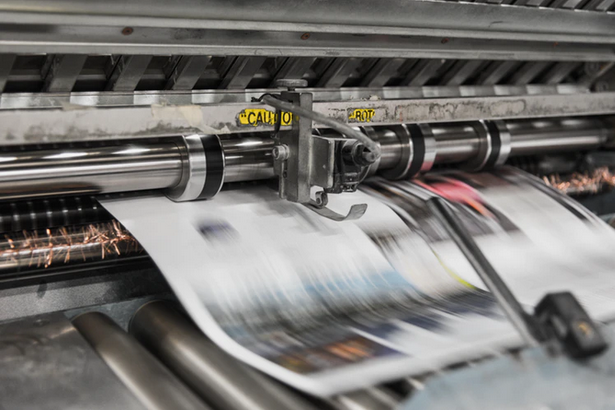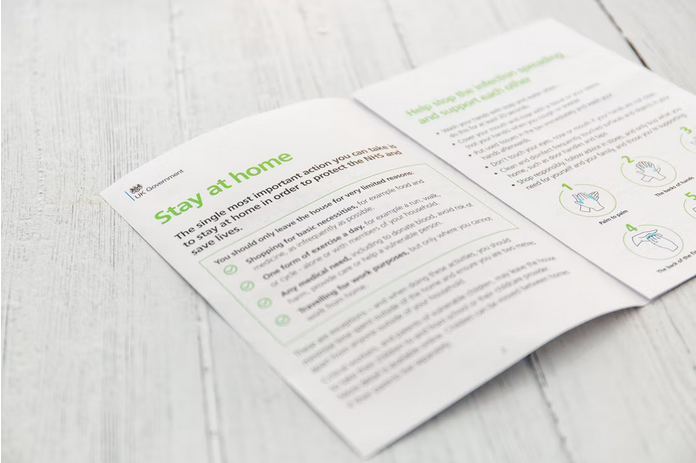Here’s why brochure marketing deserves a spot in your marketing arsenal.

Are business brochures still relevant today?
No one would blame you for pondering if brochure advertising is still worth investing in, in this hyper digital age.
In fact, you might be asking yourself:
- Does it make sense to spend time, money, and effort to design a brochure when the same information – and more of it – can easily be found online?
- Wouldn’t limited resources be better spent on digital ads or online initiatives?
- Don’t brochures just get thrown out these days anyway?
Honestly, these are all valid questions.
But here’s the thing: If you want to increase awareness and grow your business, then you need to be where your customers are. And the reality is, your prospects aren’t always online!
They’re also in retail stores, hanging out in hotel lobbies, visiting trade fairs, and seeking assistance at information counters.
So what does that mean for you?
First, print is not dead yet. Second, it’s not a good idea to rely purely on online channels (and electronic brochures) to promote your products, services, or brand.
Truth is, you’ll get better results from an inclusive approach that combines old-school techniques, like pamphlet marketing, with modern marketing to gain any advantage you can over your competitors.
What types of businesses still use brochure advertising?
There are no hard-and-fast rules regarding who should or shouldn’t be using marketing brochures. Having said that, print materials like brochures, catalogues, pamphlets, leaflets and flyers remain particularly beneficial in the following industries:
- Automotive
- Travel & tours (while you’re here, be sure to check out these fascinating travel brochure statistics)
- Wellness
- Medical / healthcare services
- Electronics
- Household appliances
- Real estate
- Education
- Banking and finance

How effective are brochures in marketing? These are your frequently asked questions.
Can implementing a brochure marketing strategy truly help your business?
Whether you’re thinking about developing a travel catalogue, health brochure, or realtor flyer, you probably want to know the effectiveness of brochures. Well, the following brochure statistics make some great food for thought!
(Hint: Brochures are particularly useful for small businesses with a limited budget for advertising.)
Q: Do catalogues and other print materials have an impact on buying decisions?
A: You bet they do! According to Snap, a Nielsen consumer study of 9,000 participants found that 62% of those surveyed rated print materials like catalogues and brochures the most effective advertising channel.
Takeaway: Done right, brochure marketing can stimulate purchase intent.
Q: Does print collateral work on Millennials?
A: Surprisingly, Millennials respond really well to the likes of leaflets, brochures, and even catalogues! Take a look at how analog approaches stand in contrast to their “sexier” online counterparts.
| Print Collateral | Digital Media |
| 77% of Millennials take notice of direct mail | 51% of Millennials take notice of email marketing |
| 73% of Millennials take notice of retail inserts | 50% of Millennials take notice of online ads |
| 54% of Millennials take notice of catalogues | 48% of Millennials take notice of mobile text messages |
| 51% of Millennials take notice of magazines |
Takeaway: Interestingly, print materials trump digital. It appears that brochures have some kind of ‘novelty’ factor that Millennials actually pay attention to!

Q: What do people do when they receive handouts or direct mail like catalogues, pamphlets, and flyers?
A: Here’s what various surveys found:
- 78% of recipients take a quick look at it while 23% read through it properly
- 50% of individuals use them for price comparisons
- 38% keep print collateral like flyers for at least a few days while 13% of individuals keep them for longer than a week
- 36% head online to learn more about a specific offer
- 36% to 48% go to the store for more information or to make a purchase
Takeaway: While a large number of marketing emails go unread, at least 3 out of every 4 recipients will take a look at your brochures or flyers. And here’s a huge bonus: At least 1/3 of recipients are likely to take relevant action!
Q: How does print marketing compare to other forms of advertising?
A: Well, according to Direct Letter Box Marketing:
- 62% of individuals don’t pay attention to TV ads – they either change the channel or put the TV on mute
- 81% skip magazine and press adverts
- 79% of print marketing recipients either keep, browse the brochure / leaflet’s contents, or pass it on to a friend
Takeaway: Business brochures beat other mediums at keeping audience attention.

What are the benefits of brochures in marketing?
The above-mentioned takeaways offer some pretty compelling reasons to give brochure advertising a try. But if you aren’t fully convinced just yet, then these truly attractive benefits of brochure marketing may just be the impetus you need to get started.
1. They can be far easier on the pocket.
For small businesses, brochures and pamphlets can be far more economical than online ads. Here’s why.
- These days, you no longer need to hire a graphic designer to create professional-quality brochures. Thanks to drag-and-drop or WYSIWYG programs, you can do it all on your own.
- In the long run, brochures can cost less than what you would spend on online ads. This is particularly true if you consider the following:
- Some keywords are incredibly pricey—they can run up to $50 per click! How many of those clicks are real leads and how many will actually convert?
- Most people—yourself included—automatically ignore the large majority of banners, popups, and yes, sometimes even search engine ads that appear online. If that’s the case, are they even worth the ad spend?
2. Small business brochures are a great way to get your foot in the door.
There are several ways your target audience can get a hold of your brochures.
- You personally hand them out to individuals you believe to be your ideal customer.
- They get sent out as (addressed or unaddressed) direct mail.
- Individuals choose to pick up your brochures because they have taken an interest in your products, services, or in what you do.
- You place them in packaging inserts in the fulfillment of online orders.
As long as you’re not handing your brochures out willy-nilly, there’s a very good chance they end up in the hands of individuals who want them and are most likely to take action.
In short, brochures can be the opening you need to introduce your company, products, and services or announce in-store promotions to a receptive audience!

3. You can make a great first impression with brochures!
I was at the mall not too long ago where I picked up several marketing brochures for different smartphone models from leading brands. And guess what? I couldn’t help but be drawn to the models advertised on what I deemed to be the more attractive brochure—at least at first glance.
(Naturally, researching product specifications, reading reviews, and pricing considerations would follow.)
All this to say, beautiful brochures are a surefire way to impress potential customers. Because although we know we shouldn’t judge a book by its cover, we still do!
Speaking of first impressions, how do you create an effective brochure?
Well-made brochures aren’t just printed on high-quality paper. They’re also aesthetically pleasing with attractive images and an appealing color palette. Equally important, they contain eye-catching headlines, engaging copy, and a powerful call to action that persuades the reader to do something. For example: Scan a QR code for more information; contact the sales representative for a quote; or head online (or back to the store) to finally make a purchase.
4. Pamphlets strengthen your online initiatives.
We all know the saying not to put all our eggs in one basket. Well, the same applies to advertising. If you’re only marketing online, chances are you’re missing a good chunk of viable offline prospects.
So rather than leaving your digital efforts to stand alone, brochure marketing is an excellent way to support—if not reinforce—online effort with smart tie-ins. For example: A brochure that provides a URL to a relevant landing page.

5. Print materials like catalogues, brochures, and flyers grow your visibility.
Fed up with battling it out online for just a few seconds of your target audience’s attention? Frustrated that you’re not gaining any headway building brand awareness?
You’re not alone. The internet is a highly competitive environment, so winning anyone’s attention can be a real challenge.
For small businesses, in particular, it can require herculean efforts just to break through all the digital noise. (Sometimes to no avail.) And yet many still relegate brochures to the sidelines. Why? Online is deemed the smarter choice since we’re all stuck to our screens anyway.
Except customers aren’t confined to the internet! They’re visiting trade shows, attending conferences, shopping at the mall, sitting in a doctor’s waiting room, looking for information at airport information counters, browsing hotel lobby literature racks, or simply hanging out in their neighborhood.
Brochures target precisely those individuals! And when distributed properly, print materials are a powerful (and cost-effective) way to boost awareness amongst an interested audience.
6. Brochures make a stronger impact.
A 2018 study found that information in print – like direct mail, brochures, and flyers – can lead to “better brand sentiment and longer-term recall” compared to digital.
What does that mean for you?
First, that we tend to remember what we read in a brochure (and the brand behind it) for a longer period of time than if we read it online. Second, we tend to like brands with print information better!
Makes sense considering:
- Unlike online ads or even electronic brochures, print brochures are tangible. You literally hold on to them, so they’ll either get read immediately, stay on someone’s desk, or get filed away for a later date. In other words, there are more opportunities for its contents to be seen again and again over a longer period of time.
- Brochures are often picked up or accepted willingly, i.e. of one’s own volition. That means the recipient is more likely to read it, keep it, and be interested in what’s written in it!
- Recipients can also make notes on the brochure or leaflet, highlight key points, and effortlessly share it with family, friends, and colleagues as needed, which makes them really handy to have around.
All this to say, even though our lives are increasingly reliant on digital, we still appreciate – and in some cases even prefer – printed materials. So if you aren’t already doing so, now is a great time to add brochure marketing to your sales tool kit!